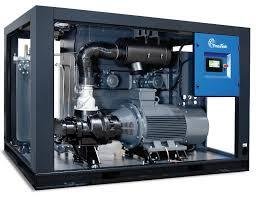In today’s competitive industrial landscape, energy efficiency is more than just a buzzword—it is a necessity. Businesses are constantly seeking solutions that help lower operational costs without compromising performance. Compressed air systems are a major component of many industries, powering machinery, tools, and processes. However, traditional air compressors are notorious for their energy consumption, often contributing significantly to high electricity bills. This is where Rotary Screw Compressor technology shines. It not only ensures reliable performance but also offers a highly energy-efficient alternative for various applications.
This blog explores how rotary screw compressor technology works, why it is energy-efficient, and the numerous ways it helps businesses save on costs while supporting sustainable practices.
Rotary Screw Compressor Technology
Before diving into the energy-saving benefits, it’s important to understand how a rotary screw compressor functions. Unlike piston compressors that use reciprocating motion to compress air, rotary screw compressors utilize two interlocking helical rotors. As these rotors turn, they trap air between them, reducing its volume and increasing its pressure before delivering it to the system.
This continuous compression process eliminates the pulsations associated with piston compressors, leading to smoother operation, better airflow, and less energy wastage. Furthermore, rotary screw compressors are designed for 24/7 operations, making them a reliable choice for industries with high and consistent air demands.
Why Energy Efficiency Matters
Energy consumption directly impacts a company’s operating costs and carbon footprint. In fact, compressed air systems are often responsible for up to 30% of an industrial facility’s total electricity usage. Even small improvements in energy efficiency can translate into substantial savings over time.
Rotary screw compressors play a vital role in improving efficiency by minimizing energy losses and optimizing the overall air compression process. These energy savings extend beyond just cost benefits—they also help companies meet sustainability goals and comply with environmental regulations.
How Rotary Screw Compressors Save Energy
Now let’s explore the specific ways rotary screw compressors achieve impressive energy efficiency.
1. Variable Speed Drive (VSD) Technology
One of the most significant advancements in rotary screw compressors is the integration of variable speed drives (VSD). A VSD adjusts the motor speed based on air demand, meaning the compressor only works as hard as necessary. Traditional fixed-speed compressors often run at full capacity regardless of demand, wasting energy.
By matching output to actual requirements, VSD-equipped rotary screw compressors can reduce energy consumption by up to 35–50%, offering substantial cost savings.
2. Reduced Air Leakage
Air leaks are a major energy drain in compressed air systems, leading to unnecessary operational costs. Rotary screw compressors are designed with tighter sealing and improved components to minimize leaks, ensuring that more energy goes into delivering usable compressed air rather than being lost in the system.
3. Efficient Cooling Systems
Overheating reduces compressor efficiency and can lead to energy waste. Rotary screw compressors use advanced cooling systems, including air and oil coolers, to maintain optimal operating temperatures. This prevents energy loss caused by overheating and ensures the compressor operates at peak efficiency for longer periods.
4. Continuous Operation without Frequent Start-Stops
Unlike piston compressors, which repeatedly start and stop to meet demand, rotary screw compressors provide continuous air supply. This not only improves efficiency but also eliminates the energy-intensive surges that occur when restarting motors frequently. The result is smoother energy usage and lower power costs.
5. High Air Output Per kW
Rotary screw compressors are more efficient at converting electrical energy into compressed air. They produce a higher air output (measured in CFM) per kilowatt of energy consumed compared to traditional compressors. This improved conversion ratio is key to lowering energy usage over time.
6. Reduced Downtime and Maintenance Costs
While not directly tied to energy consumption, reduced downtime plays an indirect role in improving efficiency. Rotary screw compressors require less maintenance than piston compressors, meaning they spend more time running optimally and less time idling or consuming energy unnecessarily.
Long-Term Cost Savings
Switching to a Rotary Screw Compressor may require a higher initial investment compared to piston compressors, but the long-term cost benefits are undeniable. The reduced energy consumption, lower maintenance costs, and longer lifespan of rotary screw compressors make them a cost-effective solution for businesses of all sizes.
For example, facilities that switch to a VSD-equipped rotary screw compressor often recover their investment in just a few years through energy savings alone. When factoring in the reduced downtime and maintenance needs, the return on investment becomes even more appealing.
Environmental Benefits
Energy savings aren’t just good for business—they’re also good for the planet. Lower energy consumption means fewer greenhouse gas emissions, helping industries reduce their carbon footprint. Many modern rotary screw compressors also use eco-friendly lubricants and materials, further supporting environmental sustainability.
For businesses aiming to meet green certifications or participate in corporate sustainability programs, upgrading to an energy-efficient rotary screw compressor is a step in the right direction.
Choosing the Right Rotary Screw Compressor
Not all rotary screw compressors are created equal. To maximize energy savings, businesses should consider key factors when selecting a compressor:
-
Air Demand: Choose a compressor sized appropriately for your operation to avoid energy waste from overcapacity.
-
Variable Speed Options: Opt for VSD technology if your air demand fluctuates.
-
Integrated Features: Look for models with built-in dryers, filters, and smart control systems to further improve efficiency.
-
Brand Reputation & Support: Invest in compressors from reputable manufacturers offering strong after-sales service and maintenance plans.
Final Thoughts
In an age where energy efficiency is crucial for both cost management and environmental sustainability, rotary screw compressors stand out as a superior solution. By combining advanced technology with robust design, these compressors deliver consistent, high-quality compressed air while significantly reducing energy consumption.
Whether you are operating a small workshop or a large manufacturing facility, investing in a Rotary Screw Compressor can lead to substantial long-term savings and improved productivity. With the right system in place, businesses can reduce operating expenses, enhance reliability, and contribute to a more sustainable future.





